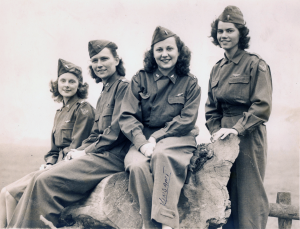Third in a Series of Ten Blogs offering A Short History of Nursing from antiquity through the mid-twentieth century. Part 1 – From Sacred to Secular – covers nursing in ancient times through the Crimean War. Part 2 – From Civilian to Military – continues with the establishment of the Saint Thomas School of Nursing through World War II.
A Short History of Nursing
Through World War II
Part 1 From Sacred to Secular Nurses
Hirelings and Hospital Nurses
England already employed two types of nurses, for hospitals and for private duty, both untrained and differing only in social status. The majority of nurses were of the working class, known as handywomen, hirelings, or domiciliary nurses who might augment their domestic work as charwomen or laundresses by hiring themselves out to nurse the sick, deliver babies, and lay out the dead. 1 Tooley notes that “Women cut off from respectable occupation were in those days seen standing outside the big London hospitals, like dock labourers waiting for a job” and were employed for scrubbing and nursing as required. 2 Charles Dickens immortalized the handywoman-as-nurse in the fictional Sairey Gamp and Betsy Prig whose moral character and insensitive behavior came to exemplify all that was wrong with nursing and created a stereotype that has plagued the profession of nursing ever since. 3
For those families who could afford it, private nurses were of a higher social class and offered more specialized – though still untrained – care than the handywoman. Their status in the household was ambiguous, and their role was marginal much like that of a governess. 4 One could surmise that they sought employment for the same reasons. As Robert Dingwall and coauthors note, “the social distinctions are important: Private nurses were integrated into the service of the affluent while handywomen were autonomous workers among the poor.” 5
Early in the nineteenth century, medical staffs of London’s teaching hospitals were concerned about the lack of reliable care that their patients received from nurses of poor character, especially the night staff who left the wards with patients unattended and often returned inebriated. When actually on duty, the nurses displayed coarseness of speech, bad manners, and ill tempers. A more refined woman was needed who would elevate the tone of the wards while attending to the needs of patients.
In the first half of the century, the main problems were keeping nurses sober and on their wards; at mid-century, the need for clinical nursing expertise became equally important. “The introduction of anaesthesia in 1846,” Carol Helmstadter writes, “led to an increase in the number and sophistication of operations and intensified the need for better surgical nursing while at the same time, as the new supportive treatments took hold, medical nursing became more labour-intensive.” 6 And as nursing care became more complex, the need for training became more evident. In addition, developments in medical practice over the past decades “were leading doctors to demand different qualities and knowledge from those who actually spent long periods of time at the bedside.” 7 Doctors needed to know how their patients were faring in order to provide appropriate interventions but found it “an uneconomic and uninteresting” use of their time “simply to observe progress.” 8 If well trained in the necessary knowledge, nurses could fill that gap as reliable observers of disease and notify the doctor when his presence was needed.
To learn how the history of nursing was reflected on the opera stage, see Judith Barger, The Nurse in History and Opera: From Servant to Sister (Lexington Books, 2024).
Notes
- Robert Dingwall, Anne Marie Rafferty, and Charles Webster, An Introduction to the Social History of Nursing (London: Routledge, 1988), 16.
- Tooley, History of Nursing, 77.
- Charles Dickens, The Life and Times of Martin Chuzzlewit [1843–1844] (New York: Knopf, 1994). Mark Bostridge notes: “Mrs Gamp may have been broad caricature, a byword for lax immorality and insobriety, but her instantaneous popularity underlines the fact that she embodied certain truths about the kind of hired nurse employed by both rich and poor.” See Mark Bostridge, Florence Nightingale: The Making of an Icon (New York: Farrar, Straus, and Giroux, 2008), 94.
- Dingwall, Rafferty, and Webster, Social History of Nursing, 14–15.
- Ibid., 16.
- Carol Helmstadter, “Early Nursing Reform in Nineteenth-Century London: A Doctor-Driven Phenomenon,” Medical History 46 (2002): 333.
- Dingwall, Rafferty, and Webster, Social History of Nursing, 32.
- Ibid., 23.
Featured Image:
the-australian-national-maritime-museum-9cHrXOvbj38-unsplash.jpg


